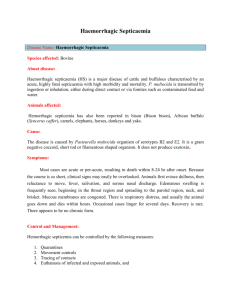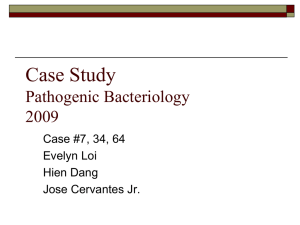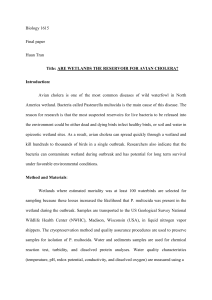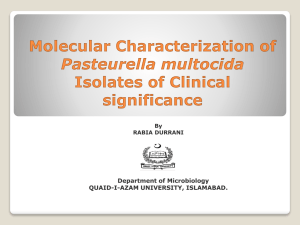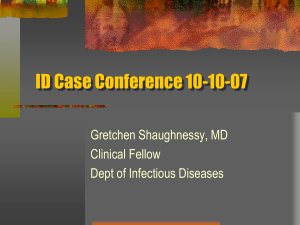Document 14111211
advertisement
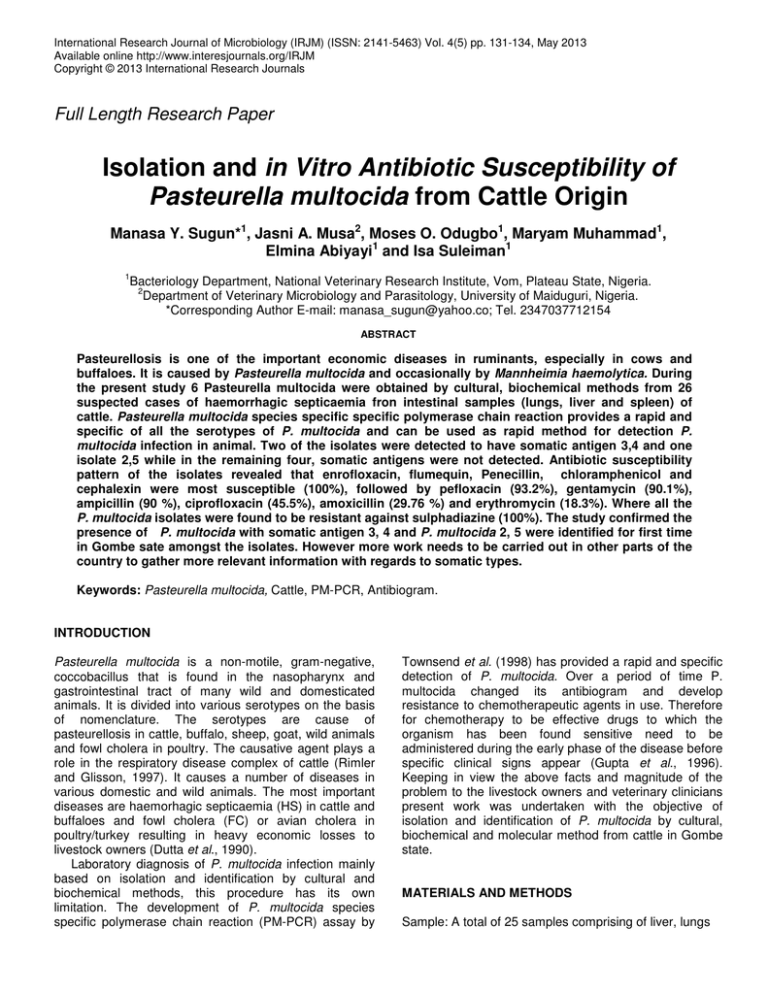
International Research Journal of Microbiology (IRJM) (ISSN: 2141-5463) Vol. 4(5) pp. 131-134, May 2013 Available online http://www.interesjournals.org/IRJM Copyright © 2013 International Research Journals Full Length Research Paper Isolation and in Vitro Antibiotic Susceptibility of Pasteurella multocida from Cattle Origin Manasa Y. Sugun*1, Jasni A. Musa2, Moses O. Odugbo1, Maryam Muhammad1, Elmina Abiyayi1 and Isa Suleiman1 1 Bacteriology Department, National Veterinary Research Institute, Vom, Plateau State, Nigeria. 2 Department of Veterinary Microbiology and Parasitology, University of Maiduguri, Nigeria. *Corresponding Author E-mail: manasa_sugun@yahoo.co; Tel. 2347037712154 ABSTRACT Pasteurellosis is one of the important economic diseases in ruminants, especially in cows and buffaloes. It is caused by Pasteurella multocida and occasionally by Mannheimia haemolytica. During the present study 6 Pasteurella multocida were obtained by cultural, biochemical methods from 26 suspected cases of haemorrhagic septicaemia fron intestinal samples (lungs, liver and spleen) of cattle. Pasteurella multocida species specific specific polymerase chain reaction provides a rapid and specific of all the serotypes of P. multocida and can be used as rapid method for detection P. multocida infection in animal. Two of the isolates were detected to have somatic antigen 3,4 and one isolate 2,5 while in the remaining four, somatic antigens were not detected. Antibiotic susceptibility pattern of the isolates revealed that enrofloxacin, flumequin, Penecillin, chloramphenicol and cephalexin were most susceptible (100%), followed by pefloxacin (93.2%), gentamycin (90.1%), ampicillin (90 %), ciprofloxacin (45.5%), amoxicillin (29.76 %) and erythromycin (18.3%). Where all the P. multocida isolates were found to be resistant against sulphadiazine (100%). The study confirmed the presence of P. multocida with somatic antigen 3, 4 and P. multocida 2, 5 were identified for first time in Gombe sate amongst the isolates. However more work needs to be carried out in other parts of the country to gather more relevant information with regards to somatic types. Keywords: Pasteurella multocida, Cattle, PM-PCR, Antibiogram. INTRODUCTION Pasteurella multocida is a non-motile, gram-negative, coccobacillus that is found in the nasopharynx and gastrointestinal tract of many wild and domesticated animals. It is divided into various serotypes on the basis of nomenclature. The serotypes are cause of pasteurellosis in cattle, buffalo, sheep, goat, wild animals and fowl cholera in poultry. The causative agent plays a role in the respiratory disease complex of cattle (Rimler and Glisson, 1997). It causes a number of diseases in various domestic and wild animals. The most important diseases are haemorhagic septicaemia (HS) in cattle and buffaloes and fowl cholera (FC) or avian cholera in poultry/turkey resulting in heavy economic losses to livestock owners (Dutta et al., 1990). Laboratory diagnosis of P. multocida infection mainly based on isolation and identification by cultural and biochemical methods, this procedure has its own limitation. The development of P. multocida species specific polymerase chain reaction (PM-PCR) assay by Townsend et al. (1998) has provided a rapid and specific detection of P. multocida. Over a period of time P. multocida changed its antibiogram and develop resistance to chemotherapeutic agents in use. Therefore for chemotherapy to be effective drugs to which the organism has been found sensitive need to be administered during the early phase of the disease before specific clinical signs appear (Gupta et al., 1996). Keeping in view the above facts and magnitude of the problem to the livestock owners and veterinary clinicians present work was undertaken with the objective of isolation and identification of P. multocida by cultural, biochemical and molecular method from cattle in Gombe state. MATERIALS AND METHODS Sample: A total of 25 samples comprising of liver, lungs 132 Int. Res. J. Microbiol. and spleen were collected from suspected cases of haemorrhagic septicaemia in cattle in Gombe state Nigeria. Isolation and biochemical characterization of P. multocida Five percent sheep blood agar was used as a primary culture medium for preliminary isolation of P. multocida isolates. Titurated tissue sample was first inoculated on 0 BA and incubated at 37 C for 24-48 hrs. The colonies suggestive of P. multocida were subjected to gram staining, catalase test, oxidase test, growth on Mac conkey agar, indole test, nitrate test and citrate test for identification. All the isolates were identified by sugar fermentation test as per method described by Cowan and Steel (1985). Identification by PM-PCR methods The isolates identified by cultural, biochemical and sugar fermentation tests were confirmed by PM-PCR using species specific oligonucleotides primer (Townsend et al., 1998) P.-multocida-specific PCR: KMT1T7 5’-ATC-CGCTAT-TTA-CCC-AGT-GG-3’, KMT1SP6 5’-GCT-GTAAAC-GAA-CTC-GCC-AC-3’ (MWG, Bangalore, India). The genomic DNA of P. multocida isolates was carried out according to Wilson (1987). Template DNA was added to the PCR mixture (total volume of 25 μl) containing 1 × PCR buffer, 200 μM each deoxynucleotide triphosphate (dNTP), 2 mM MgCl2, 3.2 pmol of each primer and 0.5 u Taq DNA polymerase. Cycling parameters for a Corbett FTS-320 Thermocycler (or similar) were as follows: initial denaturation at 95°C for 5 minutes; 30 cycles of 95°C for 1 minute, 55°C for 1 minute, 72°C for 1 minute; with a final extension at 72°C for 7 minutes. The reaction was held at 4°C until required for electrophoresis; 5 μl of each sample was electrophoresed on a 2% agarose gel in 1 × Tris-acetate running buffer (TAE) at 4 V/cm for 1 hour. The gel was stained with 1% ethidium bromide. The amplified product was visualized as a single compact band of expected size under UV light and documented by gel documentation system (Syn Gene, Gen genius biolmaging System, UK). Specificity of PCR The specificity of PCR the standardized PCR was tested by screening standard reference strain of P. multocida (B standard strain) which was procured from National Veterinary Research Institute vom Nigeria. Somatic typing of isolates Determination of somatic serotypes by the agar gel immunodiffusion (AGID) test (Heddleston et al., 1972) was performed. The isolates were typed using the procedure of Hendleston et al. (1972), and the source of antisera used was from chicken. A panel of of 16 reference antibodies made against (Henddleston et al., 1972) reference serotypes 1-16 was used in the typing procedure. Antigen and antisera controls were used in each test. Antibiotic susceptibility pattern The in vitro antibiotic sensitivity pattern of P. multocida was conducted as per method of Bauer et al. (1966). Antibiotic disc (Hi Media Ltd, Mumbai, India) used in the present study were: choramphenicol (30µg), amoxycilin (30µg), cephalexine (30µg), ciprofloxacin (5µg), enrofloxacin (10 µg), pefloxacin (5µg), flumeqine (5µg), sulphadiazine (300µg), Penicillin (10 i/u), Ampicillin (10 µg), Gentamicin (10 µg), and gentamycin (10 µg). The inhibition zone around each disk was measured indepently and compared with standard interpretative charts: Clinical Laboratory Standards Institute (CLSI, 2009). RESULTS Of the 26 lungs, liver, spleen, samples tested, 6 isolates from the samples were Gram negative rods, nonhaemolytic, round, grayish, smooth and mucoid colonies on Casein sucrose yeast agar (CSY) and blood agar. They were small, coccobacilli and non-motile. They were oxidase, catalase and ornithine decarboxylase positive, were urease negative and fermented glucose without production of gas, mannitol and sucrose positive but not lactose and showed no growth on MacConkey agar, reduced nitrate to nitrite, were indole positive and did not utilise citrate. The identity of the strain of P. multocida were further confirmed by PCR amplification of the gene with size of 465 bp. Figure 1 show the amplicon sizes of the gene fragments amplified by PCR. All the samples gave positive bands for species specific amplicon. The set of primers, KMT1T7 and KMT1SP6 were species specific and amplified the expected products from all isolates of P. multocida. Out of the six isolates two have somatic antigen 3, 4 and 2, 5 while in the remaining four, somatic antigens were not detected by the Hendleston et al., (1972) scheme. In the present study, all the 6 P. multocida isolates were tested for their antibiotic sensitivity pattern against 12 commonly used antibiotics and revealed sensitivity to chloramphenicol, flumequine, Penicillin, enrofloxacin and cephalexin (100%). Followed by pefloxacin (93.2%), gentamycin (90.1), ampicillin (90%), ciprofloxacin (45.5.1%), amoxicillin (29.6 %), erythromycin (18.3%) and sulphadiazine was (100%) resistant. Manasa et al. 133 Figure 1. Species specific PCR. Amplicons of P. multocida with size of 460 bp (Species specific). Lane 1- Gb1 isolate, lane 2-Gb2 isolate, lane Gb3 iisolate, lane 4-Gb 4 isolate, Lane 5-Gb5 isolate, lane 6 Gb 6 lane7-negative control, lane 8- positive control. lane M- 100 bp DNA molecular marker (Fermentas®). DISCUSSION Isolation of pasteurella multocida from cattle and has been the subject of this studies, particularly in Gombe State Metrapols. The study revealed the isolation of P. multocida most frequently from lungs. A similar study was reported by (Karimkhani et al., 2011) where 64% of isolates were isolated from lungs. All the isolates were found to be gram-negative, coccobacilli on grams staining and were failed to grow on Mac Conkey agar, these findings were in accordance with De Alwis (1996). Theses isolates were further confirmed by various biochemical tests. All isolates found positive for oxidase, catalase, indole production and reduction of nitrat. Similar findings have also been reported by Kumar et al (1996). All the isolates were able to ferment glucose, manitol, sucrose and mannose but failed to ferment maltose, arabinose, lactose, ducitol, salicin, inositol and trehalose. All the isolates were negative for citrate utilization. P. multocida species specicific PCR (PM-PCR) was performed using primer pair KMT1SP6 and KMT1T7 (Townsend et al., 1998). All the isolates of P. multocida including vaccine strain (Standard B strain) produced an amplified product of approximately 465 bp size. Other bacterial culture which were used to check out specificity of primer used did not show any amplified product (Figure 1). These were in conformity to results obtained by Dutta et al. (2001), who reported approximately 460 bp amplified product from all P. multocida isolates. It is evident from present results and earlier related reports, that PM-PCR provides rapid identification of all serotypes of P. multocida isolates and can be used as rapid method specific for detection of P. multocida infection in animal. The determination of antibiotic sensitivity in vitro of particular P. multocida isolates would certainly increase the chances of successful therapy for HS. Of the drugs recommended in cattle and buffalo, P. multocida is highly sensitive to penicillin, ampicillin, cephalothin, enrofloxacin and oxytetracycline. P. multocida also exhibited a high sensitivity to chloramphenicol and neomycin, although these compounds are not recommended for parenteral use in the two species. Our observations are generally in agreement with previous reports by different investigators (Kalhoro et al., 2019). In the study, somatic type 3,4 and 2,5 were identified among the isolates of Pasteurella multocida on using Hendleston et al., (1972) scheme. Pasteurella multocida setrotype B:2 (6:B) and E:2 (6:E) are the principal causes of HS (Carter and De Alwis, 1989). Although serotype B:2 has been mainly reported in Asian countries and E:2 in African countries, both serotypes have been recovered from the disease in some African countries (Martrenchar and Njanpop, 1994; De Alwis, 1995; Kumar et al., 2004). 134 Int. Res. J. Microbiol. CONCLUSION The results of this study have contributed to knowledge on the biology of P. multocida associated with HS in Gombe state of Nigeria. Pasteurella multocida somatic type 3, 4 and P. multocida 2, 5 were identified among the isolates. Variation in the sensitivity to different antibiotics by the isolates showed the necessity of in vitro antibiotic sensitivity before treatment. It also emphasizes the need for judicious selection of antibiotic for effective treatment. ACKNOWLEDGEMENTS The authors would also like to acknowledge the excellent technical assistance provided by Maria Dung (National Veterinary Research Institute, Vom). The work was supported by National Veterinary Research Institute, Vom. REFERENCES Bauer AW, Kirby WMM, Sherris JC, Turck M (1966). Antibiotic susceptibility testing using a standard single disc diffusion method. Am. J. Clin. Pathol., 45:493-496. Carter GR, DE Alwis MCL (1989). Haemorrhagic septicaemia. In: Adlam C., Rutter J.M., Eds., Pasteurella and pasteurellosis. London, UK, Academic Press, p. 131-160. Clinical and Laboratory Standards Institute (CLS, 2009). Performance Standards for Antimicrobial Disk and Dilution Susceptibility Test for Bacteria Isolated from Animals. Aproved Standards. Third edition Wayne-Pennsylvania, USA. Cowan, S.T. and Steel, K.J. (1985). Manual for the Identification of Medical Bacteria. Cambridge University Press, p.127. DE Alwis MCL (1995). Haemorrhagic septicaemia (Pasteurella multocida serotype B:2 and E:2 infection) in cattle and buffaloes. In: Donachie W., Lainson F.A., Hodgson J.C., Eds., Haemophilus, Actinobacillus and Pasteurella. New York, USA, London, UK, Plenum Press, p. 9-24. De Alwis MCL (1996). Haemorrhagic septicaemia: Clinical and epidemiological features of the disease. Int. Workshop on diagnosis and control of H.S. Bali.Indonesia, May 28-30. Dutta TK, Singh VP, Kumar AA (2001). Rapid and specific diagnosis of animal pasteurellosis by using PCR assay. Indian Journal Comparative Microbiology Immunology Infectious Diseass, 2: 43– 46. Dutta J, Rathore BS, Mullick SG, Singh R, Sharma GC (1990). Epidemiological studies on occurrence of haemorrhagic septicaemia in India. Indian Veterinary Journal, 67:893-899. Gupta V, Verma JC, Harbola PC, Sikdar A (1996). Drug resistance of Pasteurellamultocida field isolates. Indian Journal of Comparative Microbiology Immunology Infectious Disease, 17:171-173. Heddleston KL, Gallagher JE, Rebers PA (1972). Fowl cholera: gel diffusion precipitin test for serotyping Pasteurella multocida from avian species. Avian Diseases, 16: 925-936. Kalhoro DH, Kalhoro AB, Rind R, Kalhoro S, Baloch H (2010). In Vitro antimicrobial susceptibility of Pasteurella multocida. Pak. J. Agri., Agril. Engg., Vet. Sci., 2010, 2: 80-86. Karimkhani H, Zahraie salehi T, Sadeghi zali MH, Karimkhani M Lameyi (2011). Isolation of Pasteurella multocida from cows and buffaloes in Urmia's Slaughter House. Archives of Razi Institute, 1:37-41. Kumar AA, Shivachandra SB, Biswas A, Singh VP, Singh PV, Srivastava SK (2004). Prevalent serotypes of Pasteurella multocida isolated from different animal and avian species in India. Vet. Res. Commun., 28: 657-667. Kumar AA, Harbela PC, Rimler RB, Kumar PN. (1996). Studies on Pasteurell multocida isolates of animal and avian origin from India. Indian Journal Comparative Microbiology Immunology Infectious Diseases, 17:120-124. Martrenchar A, Njanpop BM (1994). First observation of an outbreak of haemorrhagic septicaemia due to P. multocida serotype B6 in Northern Cameroon. Revue Elev. Med. Vet. Pays trop., 47: 19-20. Rimler RB, Glisson JR (1997). Fowl cholera. In: B.W. Calnek, H.J., Barnes, C.W Beard., L.R. MacDougald and Y.M. Saif (Eds). Diseases of Poultry, 10th edn. Ames, Iowa, State University Press, pp. 143-159. Townsend KM, Frost AJ, Lee W, Papadimitrious JM, Dawkin HJ (1998). Development of PCR assays for species-and type-specific identification of Pasteurella multocida isolates. Journal Clinical Microbiology, 36:1096-1100.
